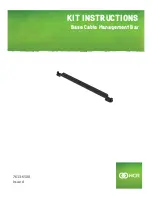
Lucent Technologies Lineage
®
2000 ECS Battery Plant H569-403
3 - 14 Engineering, Planning, and Ordering
Issue 4 February 1997
Allowable ampacity is provided in Article 310 of the National
Electrical Code (NEC), and it is a function of the following:
•
wire size,
•
ambient temperature,
•
type of insulation, and
•
proximity to other conductors.
The ampacity tables are given in the NEC, starting with Table
310-16. These tables, together with the appropriate notes,
determine the current that will result in the maximum allowable
operating temperature for each wiring method For instance, for
the maximum temperature for Type RHW wire is 75°C (167°F).
The current that will result in that temperature (i.e., the
ampacity) is less when the ambient air temperature is higher and
also when conductors are bundled or side-by-side.
Overcurrent
Protection
The rating of an overcurrent protection device (fuse or circuit
breaker) should not exceed the AMPACITY of the conductor it
is intended to protect. The absolute maximum rating permitted
by the NEC for an overcurrent protector is the next larger
standard rating above the ampacity.
Overcurrent protectors may be sized smaller than this maximum
rating. In general, however, protectors should be rated as high as
allowable to avoid nuisance tripping due to high load conditions
or inrush during start-up.
General Guidelines
The peak current drain (List 2) is used to size the circuit
protection for each individual load. The fuse or circuit breaker
must also protect the wire connecting to it in accordance with
NEC and local code regulations.
Fuses
Load fuses are not provided with the fuse panels that are
supplied with the ECS power plant. The individual fuse size
should be 150% of the List 2 current drain for the load that the
fuse is protecting.
















































